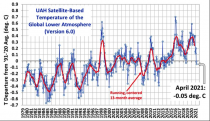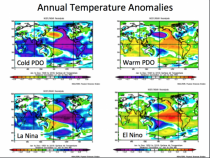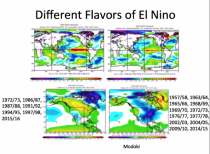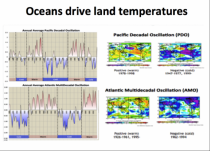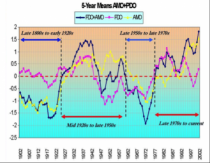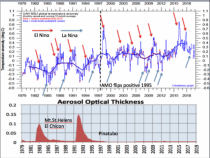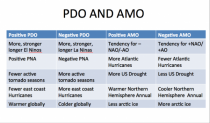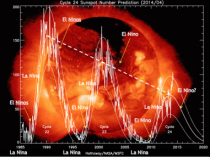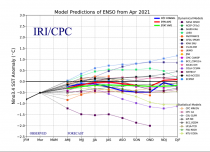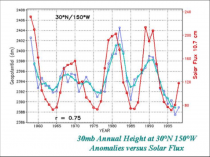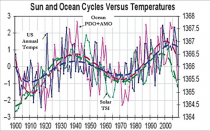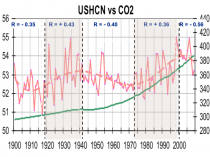Joseph D’Aleo, CCM
The latest UAH Lower Atmosphere global temperatures have dropped below the 30 year mean.
That is the effect of the latest La Nina that started last summer. Ocean temperature cycles like ENSO and the ENSO multidecadal cycle (PDO) and the Atlantic cycle (AMO) are clearly driving changes. See how PDO reflects the ENSO state.
The more persistent a cold or warm state, the more the cooling or warming. El Ninos have a cold mode with the warmth displaced to the dateline - called Modoki (right side).
The AMO (60-70 year) and PDO (60 year) cycles are out of phase.
When you add the 5-year means of the PDO and AMO, though you see the clustering producing the observed cycles of warming and cooling.
Look how the negative states are cold, positive warm.
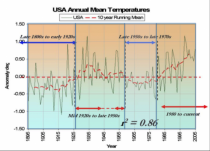
Enlarged
Volcanism or lack thereof enhances cooling or warmIng.
See how the UAH temperatures show the spike in El Nino, dips in La Nina and the cooling with volcanism and warming with the 1995 AMO flip.
The AMO and PDO are useful for seasonal severe weather too.
See “Imprint of the Atlantic Multi-decadal Oscillation and Pacific Decadal Oscillation on southwestern US climate: past, present, and future” by Petr Chylek etal here.
“The surface air temperature increase in the southwestern United States was much larger during the last few decades than the increase in the global mean. While the global temperature increased by about 0.5C from 1975 to 2000, the southwestern US temperature increased by about 2C. If such an enhanced warming persisted for the next few decades, the southwestern US would suffer devastating consequences. To identify major drivers of southwestern climate change we perform a multiple-linear regression of the past 100 years of the southwestern US temperature and precipitation. We find that in the early twentieth century the warming was dominated by a positive phase of the Atlantic Multi-decadal Oscillation (AMO) with minor contributions from increasing solar irradiance and concentration of greenhouse gases. The late twentieth century warming was about equally influenced by increasing concentration of atmospheric greenhouse gases (GHGs) and a positive phase of the AMO. The current southwestern US drought is associated with a near maximum AMO index occurring nearly simultaneously with a minimum in the Pacific Decadal Oscillation (PDO) index. A similar situation occurred in mid-1950s when precipitation reached its minimum within the instrumental records.”
--------
What drives the ENSO and larger scale oscillations?
Many months ago, I posted this chart from NASA of the SSN the last three cycles and marked the El Nino and La Nina years. Note that El Ninos appeared during the declines from solar max (go back a cycle and you find 1982/83 there too). Also El Ninos appear coming off a minimum (and before the minimums). La Ninas occur at the minimum and during the rapid rise phases.
We asked the question would the declining solar bring a stronger El Nino to 2015/16. The answer was yes and indeed a super El Nino ensued. We have been in La Nina mode the last two years at solar min but like in 2009/10, 1997/98, 1986/88, 1976/78, 1965/66, 1957/59, we might expect an El Nino to follow. Models are uncertain, typical of most springs.
It could be driven by the changes in pressure of the subtropical high pressures systems with the solar cycles which would affect the strength of the easterlies in the trade winds and equatorial zones and allow for upwelling in the east to increase or decrease.
And it appears the sun drives the ocean cycles, directly or indirectly (can’t be the other way).
The temperatures move with CO2 levels only 40% of the time since 1895.
See the latest attack on our energy economy.
OFFICE OF MANAGEMENT AND BUDGET
Notice of Availability and Request for Comment on ‘’Technical Support Document: Social Cost of Carbon, Methane, and Nitrous Oxide Interim Estimates Under Executive Order 13990’’
AGENCY: Office of Management and Budget, Executive Office of the President.
ACTION: Notice of availability and request for comments.
SUMMARY: The Office of Management and Budget (OMB), on behalf of the co- chairs of the Interagency Working Group on the Social Cost of Greenhouse Gases, including the Council of Economic Advisors (CEA) and the Office of Science and Technology Policy (OSTP), request comments on ‘’Technical Support Document: Social Cost of Carbon, Methane, and Nitrous OxideInterim Estimates under Executive Order 13990,’’ released on February 26, 2021, available here . The estimates of the social cost of carbon (SC-CO2), social cost of methane (SC-CH4), and social cost of nitrous oxide (SC-N2O), collectively called the Social Cost of Greenhouse Gases (SC-GHG), are used to estimate the value to society of marginal reductions in greenhouse gas emissions, or conversely, the social costs of increasing such emissions, in the policy making process.
DATES: To ensure consideration, comments must be in writing and received by June 21, 2021.
ADDRESSES: Submit comments by one of the following methods:
Federal eRulemaking Portal: (our preferred method). Follow the online instructions for submitting comments.
Please note that we cannot provide an option for written or faxed comments at this time due to COVID-19 protocols. Please submit comments electronically.
All comments and recommendations submitted in response to this notice will be made available to the public. For this reason, please do not include in your comments information of a confidential nature, such as sensitive personal information or proprietary information. The www.regulations.gov website is an ‘’anonymous access’’ system, which means OMB will not know your identity or contact information unless you provide it in the body of your comment.
We submitted numerous comments back in 2008 that wee summarily ignored. The Endangerment Finding from NOAA was never peer reviewed but the EPA used it as gospel and ignored comments to the contrary. They ignored the enormous benefits that fossil fuels and the gas of life CO2 provide - greening the earth and exploding food supplies. We plan to flood them again and resubmits old ones as a reminder.



